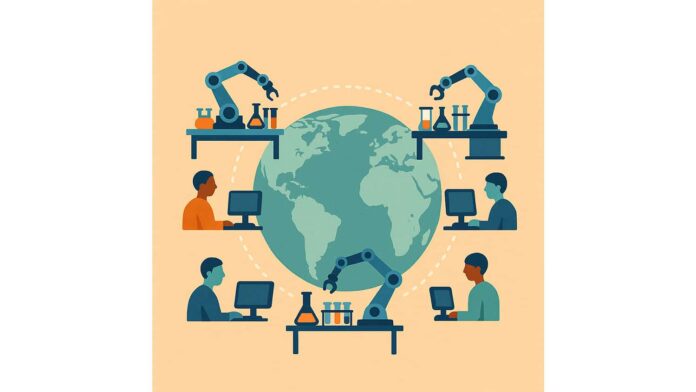An inter-disciplinary team of scientists, engineers and technologists argues that the research community should make an effort to capitalize on advancements in robotics and AI (artificial intelligence) to accelerate work that addresses sustainable energies, emerging diseases and global challenges.
“Self-driving labs (SDLs) will serve as collaborators for human researchers, significantly reducing the time and cost required to reach scientific solutions,” states
Milad Abolhasani, ALCOA Professor of Chemical and Biomolecular Engineering and expert in the field at North Carolina State University. “They will not replace the unique expertise or creativity of human researchers. Instead, these advanced technologies will streamline tedious and repetitive experimental tasks, automate data analysis, and assist in informed decision-making. This approach enables researchers to rapidly explore new ideas, push the boundaries of innovation and significantly accelerate scientific discovery.”
Abolhasani, along with a dozen of his colleagues, published a piece
Nature Communications April 24,laid out a blueprint on how SDLs could expedite valuable and important research. It also outlined how a new approach towards these tools would make them more accessible and speed up research in critical areas.
Abolhasani spoke to us about his and his collaborators’ arguments in favor of SDLs and the possible path forward.
What is a self driving lab?
Milad Abolhasani says that an SDL is basically a robotic copilot for scientific research. It automates all aspects of scientific research, from designing experiments to executing them and analyzing the results. SDLs are equipped with AI, robotics, and automation. They dynamically adapt and learn based on the results of experiments, improving their methods continuously through a closed loop process. Imagine it as a robotic collaborator powered by AI that helps scientists explore new ideas faster, streamline research workflows, and accelerate breakthrough discoveries.
What is the main idea that you and your colleagues are proposing in this article?
Abolhasani : In our article published in Nature Communications we (12 other SDL scientists from 11 institutions in the United States and Europe, and I) discuss how SDLs can enable streamlined team-science and accelerate scientific discovery on a global level.
In our article, we discuss how SDLs can enhance collaboration and innovation between different scientific disciplines. We also address the existing roadblocks that prevent this vision from becoming a reality, and propose strategic solutions such as a coordinated effort among centralized SDL facilities, and distributed lab networks. To achieve this ambitious target, we stress the importance of prioritizing federal, industrial, and academic investments to build a reliable, accessible, and robust SDL Infrastructure.
TA : Can you give examples of real-world issues or scientific advances that SDLs already addressed? Or challenges that self-driving laboratories are ideally suited to address?
Abolhasani : SDLs are already demonstrating significant reductions in time and cost to achieve solutions for critical areas like energy, environment and health care. SDLs have, for example, accelerated research breakthroughs on battery technologies, solar cells, pharmaceuticals, special materials, and wearable electronics. These discoveries were made 10 to 100 times quicker than traditional methods.
With continued advancements, SDLs could accelerate research up to 1,000 times. This makes them ideal for tackling complex multidimensional problems requiring extensive experimentation.
Let me take a step back. What are the broad benefits SDLs can provide to the research community? Why would researchers use these technologies?
Abolhasani : Researchers are increasingly turning towards SDLs to work with them as robotic collaborators, capable of navigating high dimensional experimental spaces in a highly efficient manner. SDLs allow for rapid hypothesis testing, iterative refining of experimental strategies, and intelligent exploration of complex parameter environments. These systems automate labor-intensive and repetitive processes to accelerate the research process and reduce costs. They also minimize human error. SDLs free researchers from these burdens and allow them to focus on higher order scientific questions and creativity. This allows modern, cloud-connected, team science to be performed at unprecedented speed and scale.
T: You and your colleagues talk about a coordinated project that would include centralized research facilities as well as a distributed network that works separately. What is the advantage of such an approach?
Abolhasani : Combining SDL facilities and distributed labs will ensure high-performance capabilities as well as broad accessibility. Centralized SDLs are capable of handling complex, resource-intensive, research, while distributed laboratories offer flexibility and ease-of-access, enabling scientists to participate in cutting-edge, innovative research.
T: Why is it important? Why are you and your colleagues putting forward this idea now?
Abolhasani : A coordinated effort is needed for both centralized SDLs and distributed SDLs because global challenges such as energy shortages and rapidly emerging diseases, and urgent environmental crises require solutions in months and not decades. SDLs are uniquely positioned for this urgent need. We are proposing this concerted initiative now because recent breakthroughs have made it technically possible, and the global challenges that we face make it urgently needed to rapidly deploy these advanced abilities.
What are the biggest challenges in moving forward with SDLs and this vision of science accessibility and acceleration?
Abolhasani : The key challenges include ensuring reliable technology and hardware integration, which means creating robust interoperable systems capable of consistently executing complex experimental workflows, with minimal downtime and high accuracy. To support adaptive automation and reproducibility in diverse research applications, seamless integration of hardware and software components is crucial.
The generation and management large volumes of high quality data is another foundational requirement. These data are used heavily by AI models to train, predict and improve SDLs. The reliability and generalizability are compromised without rigorous data quality standards.
Other challenges include establishing standard for knowledge transfer and enhancement. This is about creating shared protocols and formats that allow insights, learned models, and experimental strategies from one SDL to easily be transferred, reused, and built upon by other SDLs. These standards would allow seamless collaboration and integration between platforms and disciplines. This would accelerate team science and enable SDLs and other SDLs’ capabilities to be enhanced.
It is also essential to develop a skilled workforce that can design, maintain and operate these sophisticated platforms. The current SDL landscape has fragmented efforts, with many focusing on application-specific software and hardware. To enable scalable, collaborative teams science, a concerted effort is needed to develop application-agnostic SDL platforms that can serve as flexible and interoperable platforms for a variety of disciplines.
Lastly, legal and safety standards need to be carefully considered in order to ensure responsible deployment of SDL technologies and their long-term sustainability.
Can you elaborate on what you mean by legal and safety standards.
Abolhasani : Legal and Safety Standards refer to policies, certifications, and best practices that are needed to ensure SDLs operate within regulatory structures while maintaining laboratory safety and compliance. This includes the safe handling of hazardous material, traceable data practices and responsible use of AI. These standards are essential to building trust in SDL’s technologies and enabling a widespread and responsible adoption.
What are the next steps then? Where do you begin?
Abolhasani : The next step is to form strategic, large-scale partnership among academia, industry and government agencies in order to align efforts, create universal standards and secure funding for reliable SDL Infrastructure. Industry partnerships should include equipment manufacturers as well as end-users. Early pilot programs and dedicated testing beds demonstrating the effectiveness and efficiency of centralized SDL models and distributed SDLs will be crucial in validating and refining centralized and distributed SDLs.
The A: How do you envision this scenario playing out in the next 10 years if everything goes according to plan?
Abolhasani : In an ideal scenario within the next decade, SDLs would become a mainstream science partner – a robot co-pilot – for researchers around the globe, fundamentally changing how we approach scientific research. They will accelerate innovation, improve global scientific collaboration, and drive breakthroughs. This will allow us to solve complex global challenges such as energy efficiency, environmental sustainability, and personalized health care faster than ever.
/Public Release. This material from the originating organization/author(s) might be of the point-in-time nature, and edited for clarity, style and length. Mirage.News is not an institution and does not take sides. All views, positions and conclusions are those of the authors. View in full here




